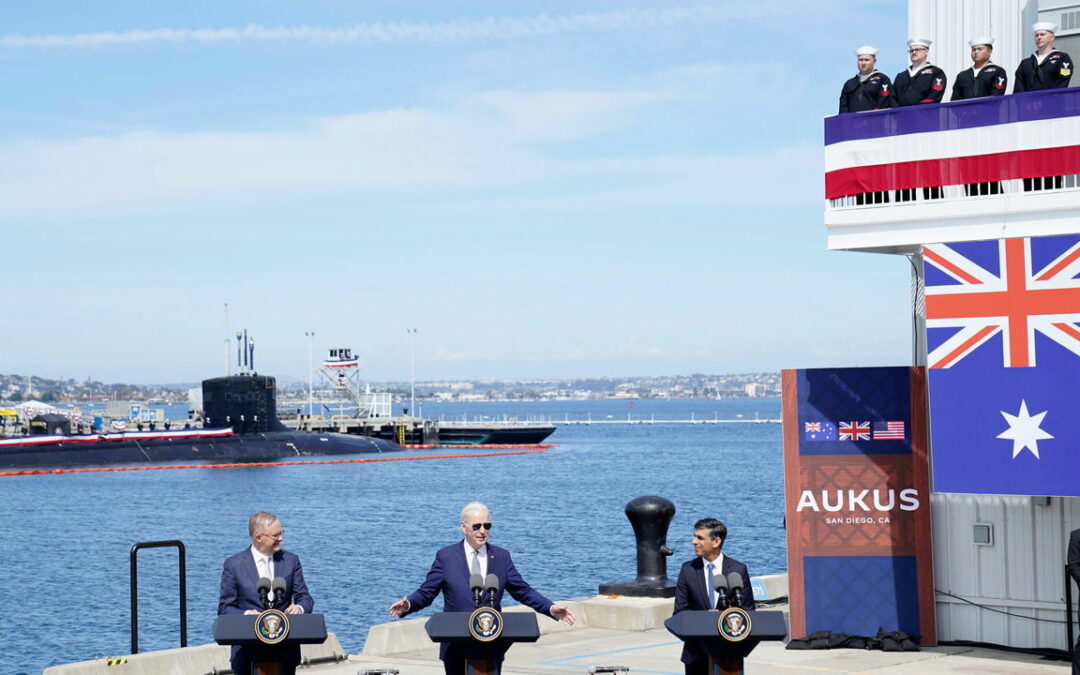ON MARCH 13TH Joe Biden, America’s president, accompanied by Anthony Albanese and Rishi Sunak, the prime ministers of Australia and Britain respectively, gathered in front of the USS Missouri, a Virginia-class nuclear-powered attack submarine in San Diego, California. The three leaders announced a plan for the implementation of AUKUS, a pact the three countries signed in September 2021. So what is AUKUS?
The core of AUKUS is a pledge by America and Britain to help Australia build at least eight nuclear-powered—but not nuclear-armed—attack submarines, which are known as SSNs (subs that carry intercontinental nuclear missiles are known as SSBNs, the “B” standing for “ballistic”). Australia had been due to buy diesel-electric boats from France to replace its current subs, which were commissioned in the 1990s. But nuclear-powered subs can stay underwater for far longer. They can carry conventional missiles, but equally important are their abilities to collect intelligence and to deploy special forces ashore.
The new sub, dubbed SSN-AUKUS, will be jointly designed by Australia and Britain. It will be based on the SSNR, Britain’s next-generation attack submarine, and augmented by American technology, including the vertical tubes that hold missiles. The first subs are to be built in Barrow, England and will be ready by the late 2030s; the first ones for Australia will be built in Adelaide, though probably not finished until after 2040, and perhaps based in Port Kembla in New South Wales. Australia’s government reckons that the programme will support 8,500 domestic jobs.
The deal also involves substantial changes to the naval posture of both America and Britain. As a stopgap, as early as 2027 America will deploy Virginia-class attack submarines, rotating up to four of them continuously through HMAS Stirling, a naval base near Perth, on Australia’s west coast. Britain hopes to send one Astute-class submarine—14% of its eventual fleet. Finally, in the early 2030s Australia will buy three to five Virginia-class subs to bridge the gap between the retirement of its current sub and the nuclear replacements. That could put a strain on America’s navy, which is struggling to ramp up production.
For Australia, all this will be what officials describe as a “whole-of-nation undertaking”. It will have to expand and upgrade HMAS Stirling to take in the new American and British subs, and eventually its own. It will invest money and manpower in American and British shipyards to expand their output. Last year the first Royal Australian Navy personnel entered America’s nuclear-propulsion training programmes; later this year its sailors will embed with the American and British navies, gaining experience. “It binds the three of us together in ways almost unimaginable for the foreseeable future”, notes a senior American official.
AUKUS has raised some non-proliferation concerns. Australia will become the first country without nuclear weapons to own a nuclear submarine (though India leased one from Russia in the 1980s and 1990s). It will also have to manage radioactive waste once the subs are decommissioned. China says that AUKUS is an “illegal transfer of nuclear weapon materials”. But although it is true that the subs will use highly enriched uranium, the reactors will be welded shut and will not require refuelling during the boat’s lifespan. The International Atomic Energy Agency, a UN watchdog, says it will engage in “very complex, technical negotiation” with the AUKUS countries to monitor any nuclear risks.
It is not all about submarines, though. AUKUS is also a broad defence-technology agreement. The three countries have established 17 joint working groups; nine of them are about subs, but the rest relate to other advanced military technologies, including underwater drones, quantum technologies for position, navigation and timing (think next-generation GPS), artificial intelligence, cyber-defence, hypersonic missiles and electronic warfare. A recent report by the Australian Strategic Policy Institute, a think-tank, showed that China has a global lead in 37 of 44 key technologies, measured by “high-impact” research papers. The idea is that by pooling talent and resources, whether on submarine construction or AI, America and its allies can compete more effectively and close that gap. ■









